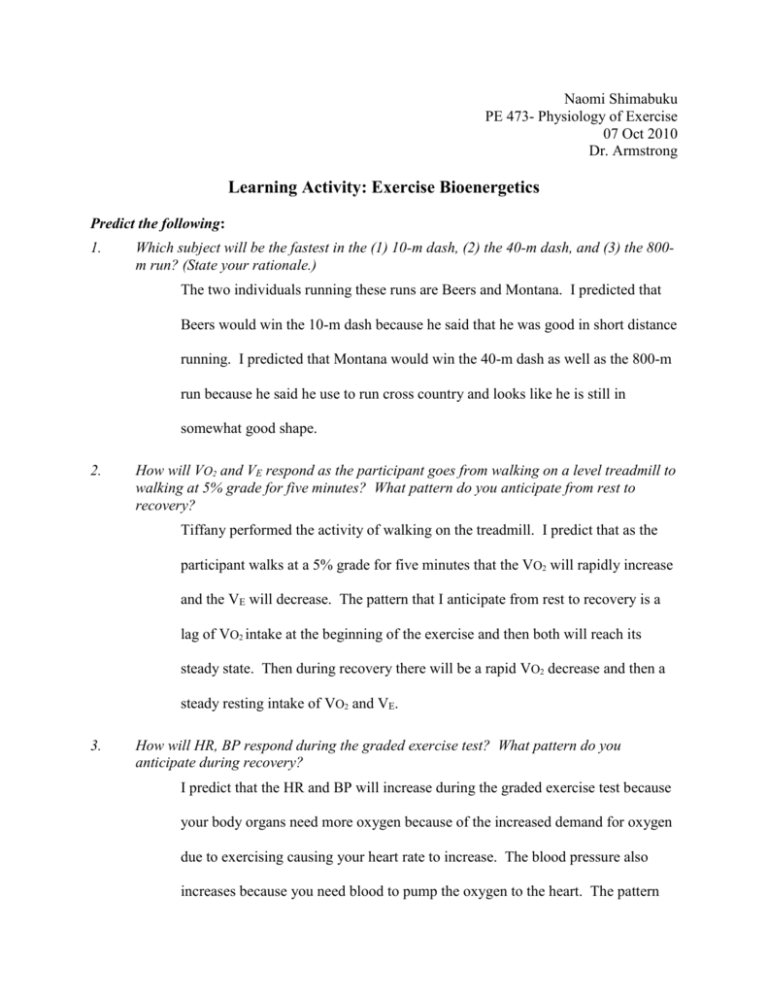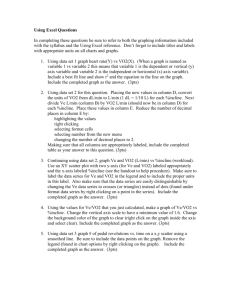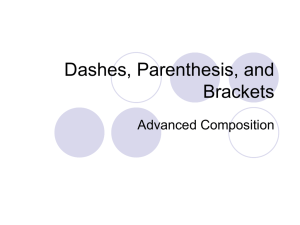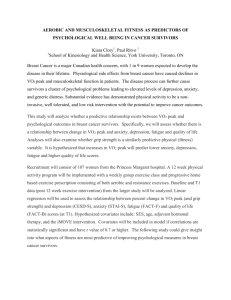PE473Activity 1 - Western Oregon University
advertisement

Naomi Shimabuku PE 473- Physiology of Exercise 07 Oct 2010 Dr. Armstrong Learning Activity: Exercise Bioenergetics Predict the following: 1. Which subject will be the fastest in the (1) 10-m dash, (2) the 40-m dash, and (3) the 800m run? (State your rationale.) The two individuals running these runs are Beers and Montana. I predicted that Beers would win the 10-m dash because he said that he was good in short distance running. I predicted that Montana would win the 40-m dash as well as the 800-m run because he said he use to run cross country and looks like he is still in somewhat good shape. 2. How will VO2 and VE respond as the participant goes from walking on a level treadmill to walking at 5% grade for five minutes? What pattern do you anticipate from rest to recovery? Tiffany performed the activity of walking on the treadmill. I predict that as the participant walks at a 5% grade for five minutes that the VO2 will rapidly increase and the VE will decrease. The pattern that I anticipate from rest to recovery is a lag of VO2 intake at the beginning of the exercise and then both will reach its steady state. Then during recovery there will be a rapid VO2 decrease and then a steady resting intake of VO2 and VE. 3. How will HR, BP respond during the graded exercise test? What pattern do you anticipate during recovery? I predict that the HR and BP will increase during the graded exercise test because your body organs need more oxygen because of the increased demand for oxygen due to exercising causing your heart rate to increase. The blood pressure also increases because you need blood to pump the oxygen to the heart. The pattern that I anticipate during recovery is that the heart rate will quickly return to resting heart rate when the resistance is taken off because the body does not need to work as hard and is recovering from the work performed even while still moving on the bike. 4. How will the individual responses differ throughout the stepping protocol? The two individuals doing the stepping activity were Joshua and I, Naomi. I predict that Joshua’s heart rate will increase higher than mine because I am currently an athlete and play soccer, therefore have a better endurance than Joshua because he only lifts and does not do as much cardio. I also predict that my heart rate will return back to resting heart rate faster because I am more of an endurance individual. Conclusions: 1. Were your predictions accurate? If not, why? Did performance differ within the individuals across the three runs (e.g., did one person perform better in the shorter distanced but not the longer)? If so, why? Explain what potential factors may have contributed to the differences in performance. Note any physiological differences (e.g., in breathing, heart rate, lactic acid “burn”, etc.) among the events. Results: Beers Montana 10m Dash 00:02.80 00:02.60 40m Dash 00:05.38 00:05.98 800m Run 03:00.00 02:37.97 My predictions were accurate, Beers won the 10m dash and Montana won the 40m dash and the 800m run. Beers performed better on the shorter distance than the long one. Montana did better in the 40m and the 800m, but barely won in the 40m. I think that Beers did better in the shorter distance because Montana is more of a distance runner, therefore not having the quick twitch muscles. Montana did better in the other two because he is a distance runner. I think that he won the 40m because he is also more in shape. At the end of the 800m Montana did not seem that winded while Beers was exhausted and was bent over breathing heavily. He also said that he ate a foot-long from Subway so he had a side-ache. Plot your data on a graph. Were your predictions accurate? What response differences might you have noted if (a) your subject was more fit or (b) less fit? Explain the physiological basis for your assumptions. Treadmill (VO2 & VOE) 4.5 4 3.5 3 2.5 2 1.5 1 0.5 0 VO2 00 6: 00 5: 00 4: 00 3: 00 2: 00 VOE 1: 0: 00 L/min 2. Time My predictions were inaccurate. Her VO2 was always more than her VE. Her VO2 did not quickly increase and did not steeply decrease during recovery. There was also no steady set point. Her VO2 continuously increased and then decreased when back to 0% grade at the same rate up. The response may be different because the individual may be more fit, where her heart rate did not increase that much, therefore there was no need for more oxygen to be pumped to the heart. I also think that another factor that may have affected the results was that there were times when she was talking during the experiment which may have affected the amount of oxygen intake and output. She may also be a “mouth breather,” therefore did not have difficulties with breathing through her mouth while her nose was plugged. At the end of the activity, she also did not seem exhausted. Our subject may be fit and is use to walking at a fast pace and at an incline. If she was more fit, then I think that her VO2 and VE would be closer together. I think that if she was less fit, then there would be a steeper incline and a greater difference between the VO2 and VE. Plot your data on a graph. Were your predictions accurate? What response differences might you have noted if (a) your subject was more fit or (b) less fit? Explain the physiological basis for your assumptions. 8:00 155/98 10:00 160/100 :0 0 143/95 13 6:00 200 150 100 50 0 :3 0 140/92 10 4:00 8: 00 132/90 5: 30 2:00 HR on Cycle Ergometer 3: 00 Blood Pressure 0: 00 Time Heartrate BPM 3. time (min) My predictions were pretty accurate. At the 8 minutes his heart rate dropped and he said he slowed down the pace because he was getting tired. As he was performing the experiment he was sweating and said that it got harder when the weight increased and had a hard time to keep going. He also began to breathe harder and sweat. He did not reach a steady max heart rate. The reason why I think that this happened was because he did not keep the steady pace when it got harder. As soon as the resistance was taken off his heart rate pretty quickly began to drop back down to his resting heart rate. Even though he was still cycling it was a part of his recovery that helped to remove the lactate more effectively. He also showed a consistent increase in blood pressure as I predicted. As he was cycling his organs needed more oxygen when there was an increase in resistance, therefore needed more blood to be pumped to the heart. I think that if our subject was more fit, his heart rate would not go as high as 150 bpm, and that he would recover faster. If the subject was less fit, his heart rate and blood pressure would both increase quicker and take a longer time in recovering. Account for the differences in responses for your two subjects. Provide a physiological basis for your conclusion. Step Exercise 300 250 200 Joshua Naomi 150 100 50 40 6: 00 6: 20 5: 40 4: 00 4: 20 3: 40 2: 00 2: 20 1: 40 0: 00 0 0: Heart rate (bpm) 4. Time (min) My predictions were correct; Joshua had a higher heart rate while performing the exercise and reached his resting heart rate slower. Both subjects reached a steady heart rate while performing the exercise. Joshua was going at a 35 step/min speed while I was going at a 30 steps/min speed. That may have affected the difference in heart rate. Another physiological basis for my conclusion is that I am currently an athlete and play soccer, therefore have a greater endurance. The exercise was not that exhausting and I did not feel much lactate acid burn. My breathing also seemed normal and I was able to calm down quickly once we had stopped. Joshua was not use to endurance like exercise, therefore had a greater heart rate. He also returned to his resting heart rate slower than I did because his heart rate was higher and he probably isn’t in as good of endurance shape as me. If we were to perform a power activity he would perform better while I perform better in endurance based on our physical fitness. NAME DATE: PE 473—PHYSIOLOGY OF EXERCISE WINTER 2010 Learning Activity: Exercise Bioenergetics (Attach and turn in with your assignment—DUE: JANUARY 21, 2010) Attendance (or approved alternative) 8 pts Predictions 4 pts Physiologically sound predictions should be provided for each activity. Conclusions 8 pts Physiologically sound conclusions should be provided for each activity. Format 5 pts Typed, 12-pt font; and grammar/spell-checked TOTAL (25 pt)








